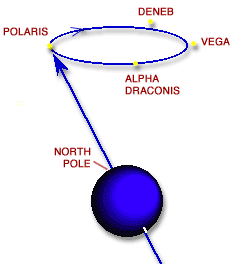

The basic tenets of astrology have long been disproved, but there are real events connected with one planet and one star that strongly affect life on earth. The planet is earth itself and the star is the sun.
Despite the apparent stability of the two, long cycles affect our
climate, and thus life. For instance, the tilt of the earth's axis varies through
time, and it's the tilt that causes our seasons; the more tilt, the stronger the
seasonal effects. The axis also wobbles, like a top running down, which changes the
time of year the northern hemisphere is pointing toward the sun. The shape our the
earth's orbit also changes, from nearly a circle to a more elongated ellipse; the
latter carries us some 3 million miles farther from the sun than the first. The orbit
also slowly rotates, affecting the season at which the earth is closest to the sun.
Today, it's in December; in another 11,500 years, it'll be in June. Stick
around; it'll be interesting to see what this does to our summer heat!

Contributor: Arthur H. Harris, Laboratory for Environmental Biology, Centennial Museum, University of Texas at El Paso.
Desert Diary is a joint production of the Centennial Museum and KTEP National Public Radio at the University of Texas at El Paso.

Precession of the axis of the earth over 26,000 years. Polaris is the current North Star. Deneb, Vega, and Alpha Draconis will, in turn, replace Polaris during the cycle. Diagram courtesy NASA/JPL-Caltech.
Precession, ice ages, and Milankovich.